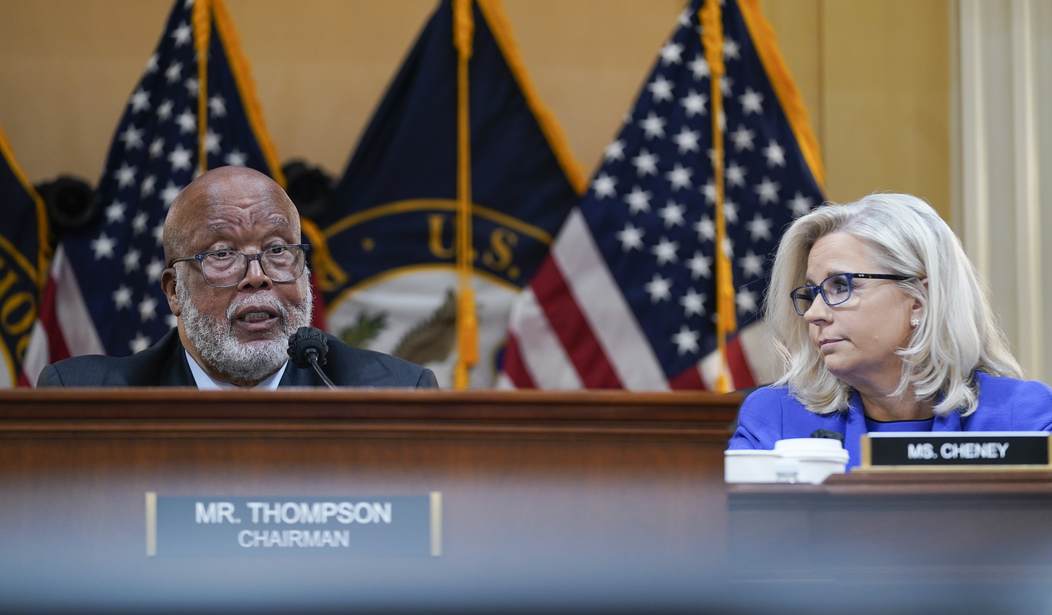Republicans take control of the House of Representatives in one week. When that happens, the Jan. 6 committee, with all its members selected by outgoing Speaker Nancy Pelosi, will go out of existence. Now, as the clock ticks down, it appears the committee's demise will leave some significant unanswered questions.
The biggest such question is: What happens to the material the committee gathered? By its own account, the committee interviewed more than 1,000 people. Some reports put the number as high as 1,200. Many of those interviews were recorded on video and transcribed, and even those that were not were memorialized in notes by committee investigators.
The committee's ten hearings, all made-for-TV affairs, featured brief snippets of video interviews. A few witnesses appeared in person for the purpose of repeating for the cameras what they had earlier told investigators. In the public show, at least, all the Pelosi-chosen members agreed on all issues, so there was no public debate or disagreement between members, nor were there any meaningful unscripted exchanges with witnesses. It was all a tightly controlled affair. The public saw only what committee leaders wanted it to see. In total, it was a small fraction of all the information the committee gathered.
Now the issue is: Will the videos and transcripts and notes of the more than 1,000 interviews be released? Here's the most important thing to remember: The committee can do what it wants. The chairman, in this case Democratic Rep. Bennie Thompson of Mississippi, decides what records the committee will archive and what records it will destroy. The House resolution creating the committee says that, upon termination of the committee, "the records of the Select Committee shall become the records of such committee or committees designated by the Speaker." But the chairman decides what is a "record" and what is not. There are inside players on Capitol Hill who believe the Jan. 6 Committee will destroy a lot of its work. It will never see the light of day.
Recommended
Thompson has been vague about what he will do. At times, he has said the committee will release "hundreds" of transcripts. Most recently, just before the release of the committee's final report, Thompson said the committee "intends to make public the bulk of its nonsensitive records before the end of the year." He added, "These transcripts and documents will allow the American people to see for themselves the body of evidence we have gathered and continue to explore the information that has led us to our conclusions."
What does that mean, precisely? It all depends on the meaning of "intends" and "bulk" and "nonsensitive." There is a lot of wiggle room in Thompson's words. The committee might well keep all sorts of things secret.
One thing is clear, and that is the committee's public disclosure has gotten off to a slow start. On Dec. 21, at the same time it released its final report, the committee released transcripts of 34 interviews. On Dec. 22, it released five more. On Dec. 23, it released 46 more. That is 85 transcripts, meaning that are at least 900, and perhaps as many as 1,100, more to be released in the next week. That period includes the New Year's holiday, so the time is particularly limited.
So far, the releases have been highly selective. For example, the committee's star witness is Cassidy Hutchinson, the former aide to former White House chief of staff Mark Meadows who on June 28 offered bombshell testimony that she heard a White House official say that then-President Donald Trump become violent when, after his Ellipse rally on Jan. 6, he demanded to be driven to the Capitol.
It was sensational testimony, and it made Democrats and many in the press very, very excited. Then the public learned that Hutchinson had done multiple transcribed interviews with the committee before her June 28 appearance. In those interviews, she apparently did not discuss the limousine incident. Then, in late June, she got a new lawyer and remembered it in great detail. She revealed it in a new interview with staff and committee vice chair Rep. Liz Cheney, the Republican who has made the committee a personal crusade against Trump. Cheney and Thompson rushed Hutchinson to the microphone in a hastily produced public hearing. After that, Hutchinson did two more transcribed interviews with the committee in September.
So far, the committee has only released Hutchinson's two transcripts from September. It has released nothing from Hutchinson's original testimony, nor has it released any record of her interview with Cheney that led to the June 28 special hearing. Also, her account obviously leads to questions about testimony from Ornato and Engel. What did they say? That's pretty important. Each has conducted multiple interviews with the committee that have not yet been released.
And, of course, there were no members of the committee who might have been even a little skeptical of the Hutchinson matter, and who might have asked questions to elicit more about the events in question. Yes, there were two Republicans on the committee -- Cheney and Rep. Adam Kinzinger -- but they were fully on board with everything Democrats did. To do otherwise, to be even a little skeptical, would be "obstructionist." A new account in the New York Times that relied on significant access to the committee put it this way: "The lack of obstructionist voices on the committee meant that the panel could proceed with a clean, uninterrupted narrative about the events of Jan. 6."
Real life is never quite as clean as the narrative that the showrunners of the Jan. 6 Committee wanted to create. Which brings things back to the question: Will the public get to see the full picture of what the committee gathered? Chairman Thompson doesn't have to show Americans anything else. He doesn't have to reveal anything that would complicate the "clean, uninterrupted narrative" that he and his colleagues created. Maybe he will, and maybe he won't.
But what about the public's right to know? Of course the public has a right to know. But that doesn't mean it will know.
This content originally appeared on the Washington Examiner at washingtonexaminer.com/opinion/for-jan-6-committee-time-for-transparency-is-running-out.
(Byron York is chief political correspondent for The Washington Examiner. For a deeper dive into many of the topics Byron covers, listen to his podcast, The Byron York Show, available on the Ricochet Audio Network at ricochet.com/series/byron-york-show and everywhere else podcasts are found.)





















Join the conversation as a VIP Member